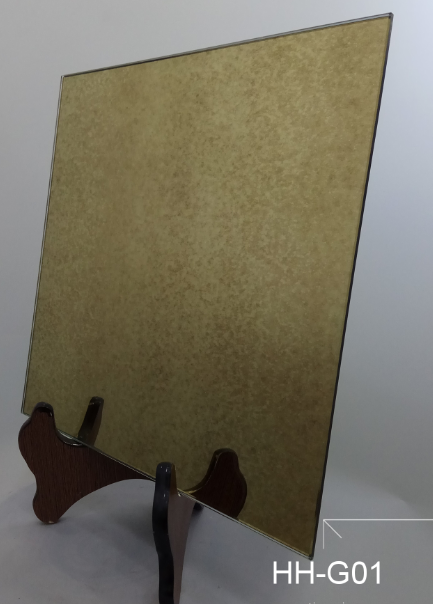Characteristics of antique mirrors of various eras
Date of release:2019-01-19 Author: Click:
The characteristics of antique mirrors of various eras, below the Xiaobian of Dongguan Huahui Glass Products Co., Ltd. for everyone to introduce in detail!
We believe that the most important thing to master the characteristics of mirrors in various eras is to express the characteristics of bronze mirrors in various eras, namely, shape, ornamentation, inscription, and copper. These have been clarified before and do not have to be repeated. There are several important features that need to be emphasized here.
The copper is different. Since the Song Dynasty is a period of important changes in the composition of copper mirror alloys in China, the amount of tin is significantly reduced, the amount of lead is increased, and the proportion of zinc is also increased. Therefore, copper and color have changed. This should be an important aspect of distinguishing between antique mirrors and real mirrors.

Song imitation mirror texture is not as good as Han Tang mirror. Softer, brassy, yellowish red. Gold-like mirrors are generally slightly yellower than the mirror-like copper. Although the palace mirror in the Ming and Qing Dynasties is brassy, the yellow mirror in the yellow mirror is white, and the yellow mirror in the yellow mirror is yellow.
The appearance is different. The difference in the composition of the alloy, the difference in texture and color, will inevitably affect the pros and cons of the bronze mirror. Song Jinxin's mirror is rough in copper, with a blurred pattern and extensive lines, which appear to be stagnation. The imitation mirror pattern of the Ming and Qing Dynasties is far less refined than that of the Han and Tang Dynasties, and it is also like Wang Jing's mirror. This is related to the fact that the amount of tin contained in the sun, the moon and the Ming and Qing Dynasties is greatly reduced, and the zinc content is greatly increased. Of course, the Ming and Qing dynasty mirrors are also very good.
Different shapes. Although the bronze mirror is generally small and the area of the mirror back is small, in this small piece of heaven and earth, the craftsmen of all ages have refurbished in various aspects such as ornamentation, inscriptions, shapes, and divisions of patterns, edges, buttons, and button holders. Extremely changeable. We compare the characteristics of different parts of different eras, and master even small changes, it is also an important aspect of distinguishing between true mirrors and mirrors. To name a few: Song imitation Tangling flower shape, sunflower shape mirror, Tang Dynasty, such mirrors are in and out of shape, and the Song Dynasty more than six out of shape, even the eight out shape, Tang and Song arc curvature is not the same.
In the Jin Dynasty imitation mirror, no matter which imitation can be a dynasty, if there is a documentary and painting of the official inspection, it is easy to distinguish.
The mirror mirrors of the Ming and Qing Dynasties are straight and angular. The difference between the buttons is large. In the Ming Dynasty, the silver ingots were mostly numerous, and the Ming and Qing dynasty buttons were flat and the area was much larger than the Song Yuan imitation mirror. More inscriptions were cast on the flat top.
add content. As mentioned above, when the original mirror was used to model the mold, the craftsmen added some ornamentation and inscriptions. According to some of the information we have seen, the additions, patterns and inscriptions in the content and form, although very random, there is no very clear law, but from the increased content of many imitation mirrors, increase the inscriptions Most of them, and the inscriptions added later are the names of the cast-glass workshops, shops and craftsmen, and very few should be the names of the bronze mirror users.
From the point of adding the inscription, there are roughly several different situations, depending on the content of the original mirror. The original mirror has only the inscription without the inscription, and the added inscription is mostly in one or two places of the pattern, which suppresses a part of the original pattern. The inner area of the original mirror is inscribed in the outer area of the ornamentation, and some of the added images are placed in the ornamentation. The original mirror has no inscription only inscriptions. If it is a single circle with an inscription mirror, the added inscription is added to the original inscription circle. If it is a two-week inscription, the added inscription is generally added to the outer ring inscription.
Roughly statistics, the added inscriptions are: Gong, Chen, Sun, Yi, Cao, Li, Lu, Zhao, Ma, Yi Jia, Cao Pu, Kong Ji, Lu Zao, Ma Qing, Lu Jiazao, Zhang Jiazao, Li Taishan made, Lipu bronze, fake Li Jingzhen is a pig, a family of bronze, Xie Shaotang made a bronze for bronze.
Some of these added contents are very obvious, while others are more subtle. Originally, the mirror is a flat surface with a small area, but it can be seen at a glance, but sometimes it is complicated and vague, not deeply noticed, and even some important records. There were also mistakes in the middle, and the imitation mirrors that added content later became the mirror of the original era.
weakness
In the knowledge of the identification, appreciation and learning of bronze mirrors, the vast number of cultural archaeologists and bronze mirror enthusiasts, as well as experts who study bronze mirrors, feel that the Warring States Han Tang mirror is easy to handle. It is difficult to mirror in the after five generations. It is precisely that it is easy to distinguish the ancients. Whether there is such a situation in other cultural relics identification, we do not want to comment, and this problem does exist in the field of bronze mirrors.
For a long time, antique collectors hobby Han Tang mirror, mentioning the bronze mirror will boast Han Tang, first, the recognition of the Warring States mirror is not enough, the second is not enough attention to the mirror after the Song, even if it is into Tibet, analysis and research are poor. Once this wind was formed, it has affected it until now, and it has only attracted the attention of scholars. The famous scholar Li Xueqin said: "The second half of the development of ancient mirrors is half-dark and half-dark, and many problems are unclear."
On the other hand, in the past 40 years, many bronze mirrors have been unearthed in the Han and Tang Tombs. The information is reliable and the research is more. Therefore, the sequence, type and development sequence of Han Tang mirrors, especially Han mirrors, are basically clear. The next step is to Researched. The seriousness of the problem lies in the fact that many cultural and cultural units, cultural relics stores and cultural relics markets have more mirrors belonging to this period. Because the times are uncertain, they are not well known. When is the history of the latter half of the history of Chinese bronze mirrors “half-dark and half-bright”, when can it be clarified? From the perspective of sorting out Chinese cultural heritage and strengthening academic research, it is imperative to strengthen the research and appraisal of bronze mirrors in the Song Dynasty and later from the needs of real collection, sorting, and solicitation.
The address of this article:http://en.henghui-mirror.cn/news/398.html
Key word:
The next one:Brief analysis of the characteristics of the embossing mirror












